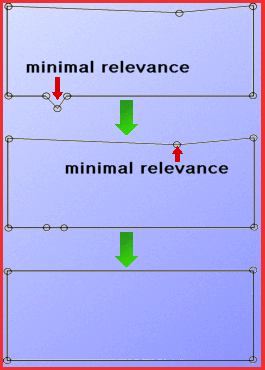
Curve Evolution
Strategy
 Assigning a relevance measure to every vertex, we can simply take out the
least important vertex by direct connection of its neighbours. We repeat this
elimination until we obtain the desired stage of abstraction.
This simple strategy is shown in the figure on the left.
Assigning a relevance measure to every vertex, we can simply take out the
least important vertex by direct connection of its neighbours. We repeat this
elimination until we obtain the desired stage of abstraction.
This simple strategy is shown in the figure on the left.
We define each vertex by its joining line segments and express the relevance measure
by a cost function K, giving the cost of eliminating this vertex. The cost function
will be derived later.
The algorithm can stated as:
Let Dm=s0,...,sm-1 be a decomposition of
a digital curve C into consecutive maximal digital line segments.
The
decomposition Dk for each stage of the curve evolution
k=m, m-1,..., 3 until Dk-1 is convex is achieved by:
Curve Evolution Procedure (Dm)
- k=m
- DO
- Find in Dk a pair si,si+1 (mod k)
such that K(si,si+1) is minimal ;
- Dk-1= Dk with segments si,si+1
replaced by the line segment s' that joints the endpoints of arc
si v si+1 ;
- k=k+1 ;
- until Dk-1 is convex.
|
Remarks:
This algorithm is guaranteed to terminate, since in every evolution step,
the number of digital line segments in the curve decomposition
decreases by one
(one line segment replaces two adjacent segments).
It is also obvious that this evolution converges to
a convex polygon, since the evolution will reach a state
where there are exactly three line segments in the curve decomposition,
which clearly form a triangle.
Of course, for many curves a convex polygon with more than three sides
can be obtained in an earlier stage of the evolution.
Thus we obtain:
Curve evolution by digital linearization converges to
a convex polygon.
 Continue with Curve Evolution: Relevance Measure
Continue with Curve Evolution: Relevance Measure
 Assigning a relevance measure to every vertex, we can simply take out the
least important vertex by direct connection of its neighbours. We repeat this
elimination until we obtain the desired stage of abstraction.
This simple strategy is shown in the figure on the left.
Assigning a relevance measure to every vertex, we can simply take out the
least important vertex by direct connection of its neighbours. We repeat this
elimination until we obtain the desired stage of abstraction.
This simple strategy is shown in the figure on the left.

 Continue with Curve Evolution: Relevance Measure
Continue with Curve Evolution: Relevance Measure